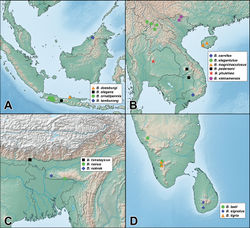Bolitogyrus nokrek
| Notice: | This page is derived from the original publication listed below, whose author(s) should always be credited. Further contributors may edit and improve the content of this page and, consequently, need to be credited as well (see page history). Any assessment of factual correctness requires a careful review of the original article as well as of subsequent contributions.
If you are uncertain whether your planned contribution is correct or not, we suggest that you use the associated discussion page instead of editing the page directly. This page should be cited as follows (rationale):
Citation formats to copy and paste
BibTeX: @article{Brunke2017ZooKeys, RIS/ Endnote: TY - JOUR Wikipedia/ Citizendium: <ref name="Brunke2017ZooKeys">{{Citation See also the citation download page at the journal. |
Ordo: Coleoptera
Familia: Staphylinidae
Genus: Bolitogyrus
Name
Bolitogyrus nokrek Brunke sp. n. – Wikispecies link – ZooBank link – Pensoft Profile
Type locality
Nokrek Biosphere Reserve, Garo Hills, Meghalaya, India.
Type material
Holotype (♂, cHay): INDIA-NE, Meghalaya, 25°27'N 90°19'E, NOKREK N.P., 1400m, Garo Hills, 26.iv.1999, Z. Koštál leg. [printed] / Bolitogyrus sp. det. Y. Hayashi 2012 [printed] / HOLOTYPE Bolitogyrus nokrek Brunke, des. A. Brunke 2017 [red label] / AJB0000395 [identifier label].
Paratypes (3 ♀, cHay, NMW): same as holotype, AJB0000505; same as holotype except: 9–17.V.1996, E. Jendek and O. Sausa, AJB0000506, AJB0000507.
Diagnosis
Within the Carnifex Group, Bolitogyrus nokrek can easily be distinguished by the darkened base of the elytra (Fig. 1G).
Description
Measurements ♂ (n = 1): HW/HL 1.33; PW/PL 1.35; EW/ EL 1.19; ESut/PL 0.76; PW/HW 1.12; forebody length 7.1 mm.
Measurements ♀ (n = 3): HW/HL 1.30–1.38; PW/PL 1.20–1.31; EW/ EL 1.17–1.23; ESut/PL 0.74–0.77; PW/HW 1.12–1.13; forebody length 6.9–7.8 mm.
Extremely similar to B. carnifex and differing only in the following: apical antennomere only slightly paler than previous; pronotum almost entirely covered by dark marking; elytral darkened basally; abdominal segments III-IV almost entirely dark; dorsal face of tibia darkened; midfemur with distinct dark subapical marking; median lobe in lateral view with small, acute apex, slightly deflexed dorsal with flat ventral face instead of tooth, basal teeth present and appearing removed from ventral face, subapical teeth absent (Fig. 12E); median lobe in parameral view slightly constricted at midlength, apical portion strongly acuminate to acute and narrow apex bearing median carina (Fig. 12D); paramere in lateral view strongly projecting beyond and deflexed over apex of median lobe (Fig. 12G); paramere with distinctly narrower apical third, median group of peg setae extending basad of thin marginal group (Fig. 12F); female tergite VIII with narrow and deep emargination; female tergite X with dome-like expansion in apical half, without distinct carinae.
Distribution
Figure 20C. Likely endemic to the Garo Hills, Meghalaya, India. Presently the westernmost species of the Carnifex Group.
Bionomics
Bolitogyrus nokrek has been collected at 1400 m in April and May.
Etymology
This species is named in recognition of the Nokrek UNESCO Biosphere Reserve in the Western Garo Hills of Meghalaya, India, where all known specimens were collected.
Comments
Two females, (Khasi Hills Meghalaya (IRSNB)), and northern Kachin State, Myanmar (SEMC)) may belong to this or additional new species. They are excluded from the type series.
Original Description
- Brunke, A; 2017: A revision of the Oriental species of Bolitogyrus Chevrolat (Coleoptera, Staphylinidae, Staphylininae) ZooKeys, (664): 1-97. doi
Images
|
Other References
- ↑ Cai Y, Zhao Z, Zhou H (2015) Taxonomy of the genus Bolitogyrus Chevrolat (Coleoptera: Staphylinidae: Staphylinini: Quediina) from China with description of seven new species. Zootaxa 3955: 451–486. https://doi.org/10.11646/zootaxa.3955.4.1

![Figure 12. Bolitogyrus magnimaculosus Cai et al. (A–C), B. nokrek Brunke (D–G), B. lasti Rougemont (H–J) and B. tigris Brunke (K–M). Aedeagus in parameral view (H, K), median lobe in parameral view (A, D), median lobe in lateral view (B, E, I, L), peg setae of paramere (C, F, J, M), paramere in lateral view (G). Figures A–C modified from Cai et al. (2015)[1]. Scale bars: 0.5 mm.](https://species-id.net/o/thumb.php?f=Zookeys-664-001-g012.jpg&width=221)
